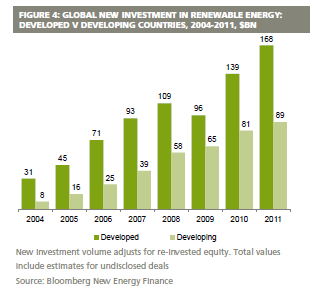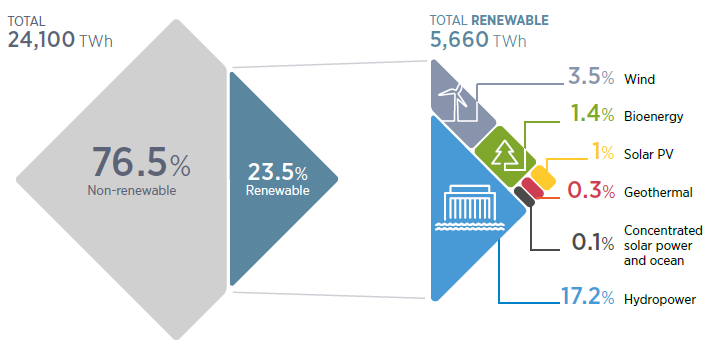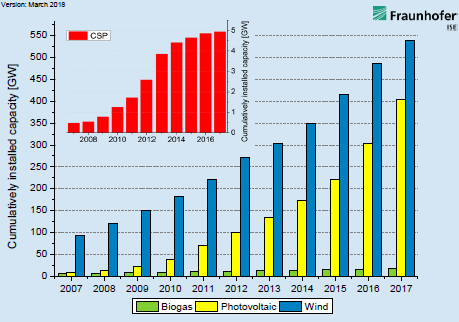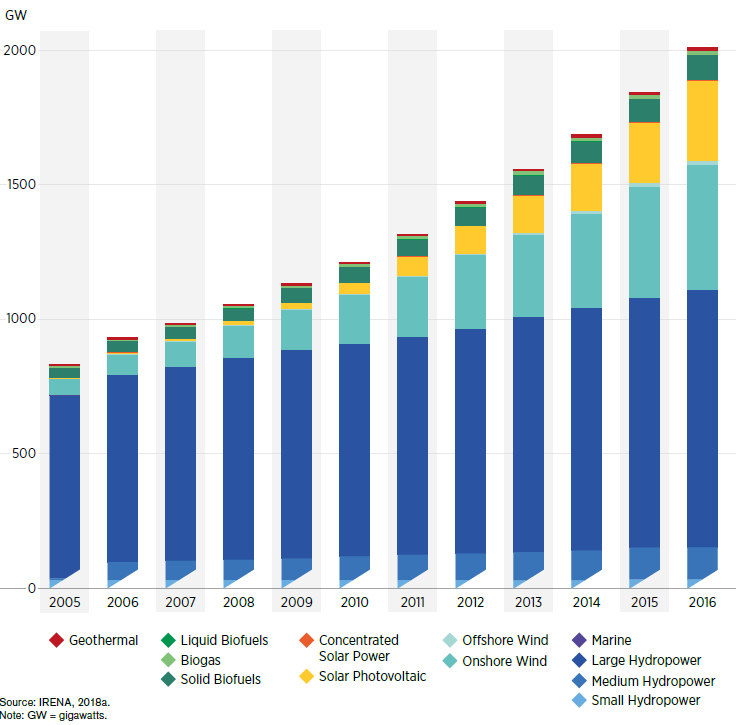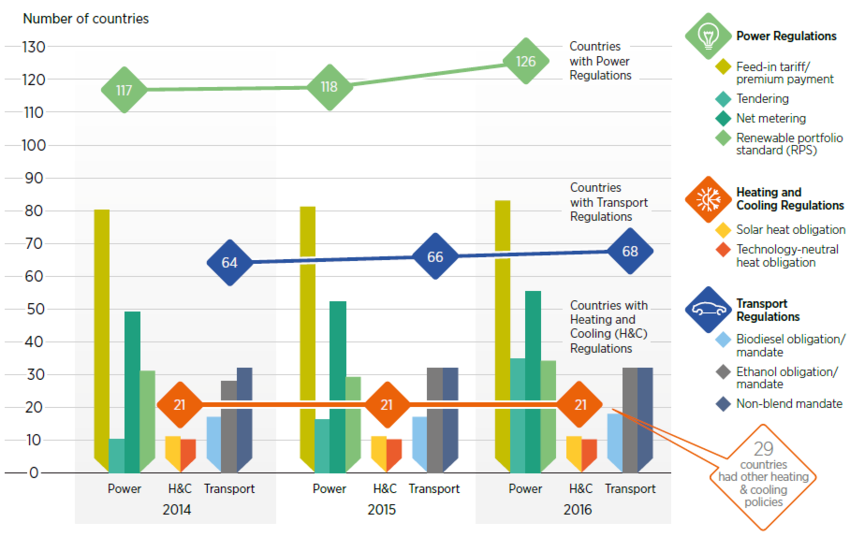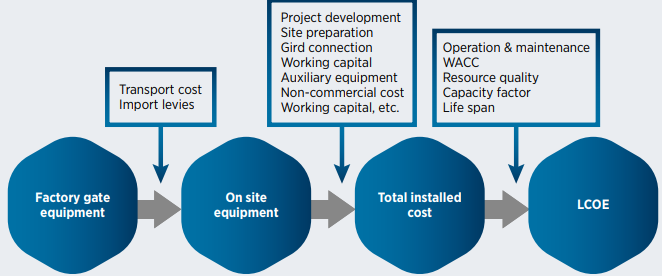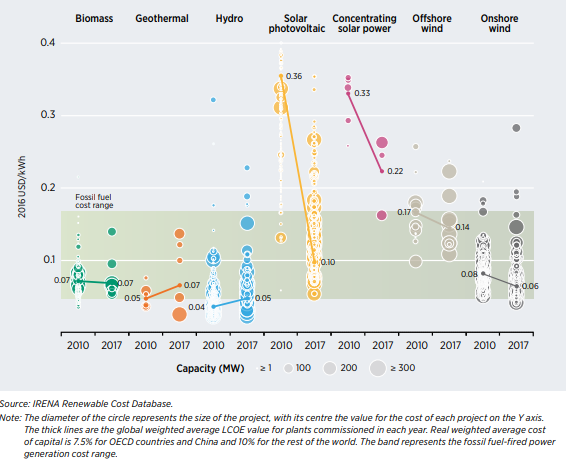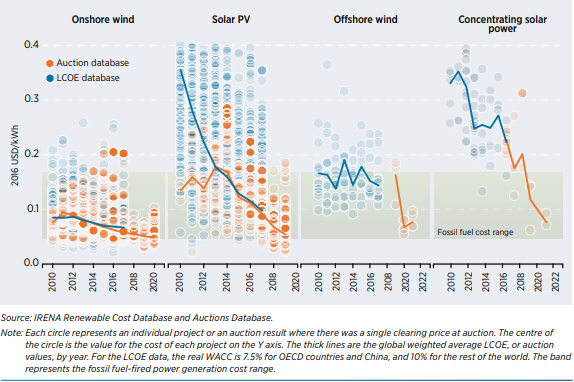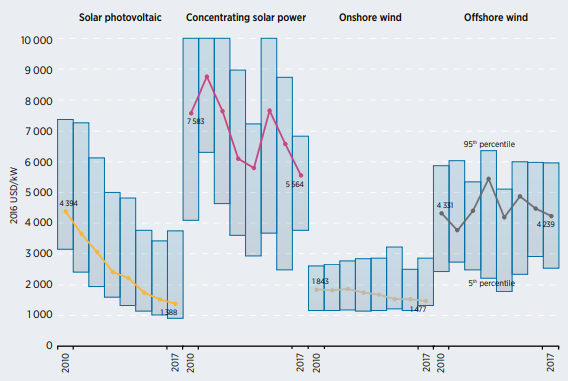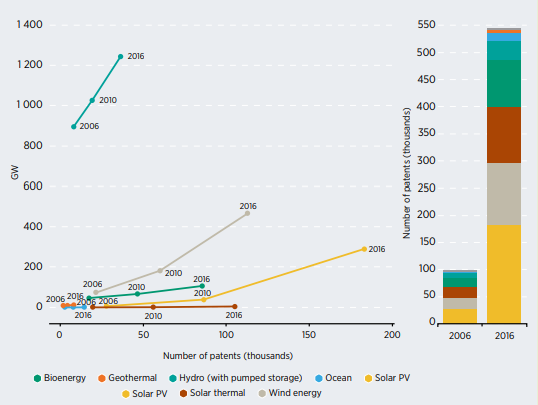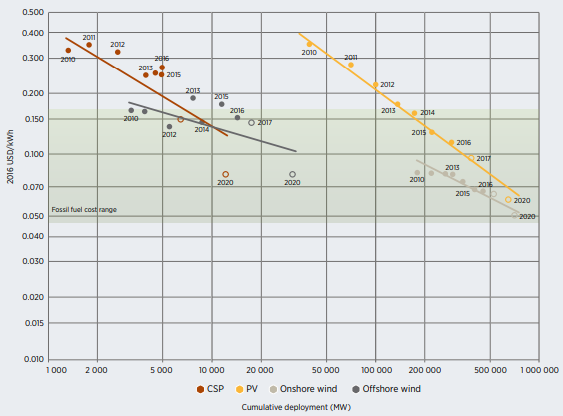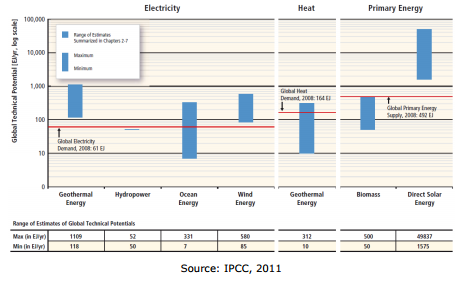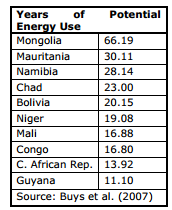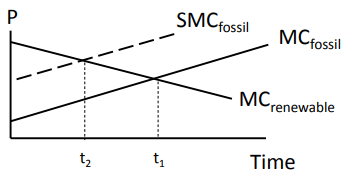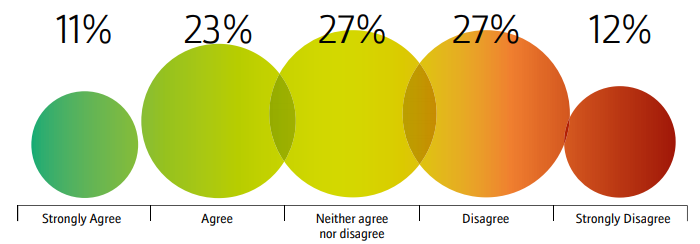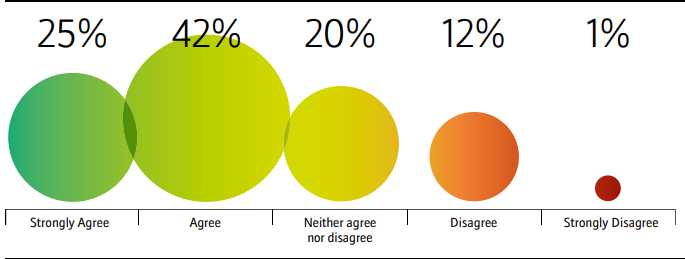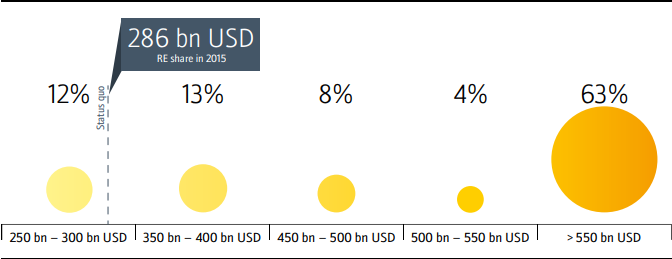Knowledge fuels change - Support energypedia!
For over 10 years, energypedia has been connecting energy experts around the world — helping them share knowledge, learn from each other, and accelerate the global energy transition.
Today, we ask for your support to keep this platform free and accessible to all.
Even a small contribution makes a big difference! If just 10–20% of our 60,000+ monthly visitors donated the equivalent of a cup of coffee — €5 — Energypedia would be fully funded for a whole year.
Is the knowledge you’ve gained through Energypedia this year worth €5 or more?
Your donation keeps the platform running, helps us create new knowledge products, and contributes directly to achieving SDG 7.
Thank you for your support, your donation, big or small, truly matters!
Difference between revisions of "The Economics of Renewable Energy"
***** (***** | *****) |
***** (***** | *****) |
||
| Line 50: | Line 50: | ||
<br/> | <br/> | ||
| − | = Rationale for <span data-scayt_word="renewables" data-scaytid="4">Renewables</span | + | = Rationale for <span data-scayt_word="renewables" data-scaytid="4">Renewables</span> = |
| − | + | Reasons which have contributed to the acceleration of both public and private investment in renewable energy<ref name="Timmons, D. Harris, J. M. & Roach, B. (2014). The Economics of Renewable Energy. Retrieved From: https://ase.tufts.edu/gdae/education_materials/modules/RenewableEnergyEcon.pdf">Timmons, D. Harris, J. M. & Roach, B. (2014). The Economics of Renewable Energy. Retrieved From: https://ase.tufts.edu/gdae/education_materials/modules/RenewableEnergyEcon.pdf</ref><ref name="Meier, P. Vagliasindi, M. Imran, M. Eberhard, A. & Siyambalapitiya, T. (2015). The Design and Sustainability of Renewable Energy Incentives: An Economic Analysis. Retrieved From: https://openknowledge.worldbank.org/bitstream/handle/10986/20524/922240PUB0978100Box385358B00PUBLIC0.pdf?sequence=1">Meier, P. Vagliasindi, M. Imran, M. Eberhard, A. & Siyambalapitiya, T. (2015). The Design and Sustainability of Renewable Energy Incentives: An Economic Analysis. Retrieved From: https://openknowledge.worldbank.org/bitstream/handle/10986/20524/922240PUB0978100Box385358B00PUBLIC0.pdf?sequence=1</ref>: | |
| + | |||
| + | #The growing demand for energy, which consequently requires a certain economic development.<br/> | ||
| + | #The fact that fossil fuels are finite, and negatively affecting the climate and polluting the air. | ||
| + | #The current critical environmental and climatic conditions, which drive the need to redirect energy technologies into more diverse, environmentally sustainable supply sources.<br/> | ||
| + | #The need to ensure future energy security. | ||
| + | #Mostly for developing countries in particular: Rapid urbanization, economic growth, uprising demographic trends and severe climate change conditions. | ||
<br/> | <br/> | ||
| Line 60: | Line 66: | ||
<br/> | <br/> | ||
| − | + | The future of the <span data-scayt_word="renewables" data-scaytid="8">renewables</span> industry depends on finance, risk-return profiles, business models, <span style="background-color: rgb(255, 255, 255);">lifetime's </span>investment and a sum of other economic, policy and social factors. Many new [[Portal:Financing and Funding|sources of finance]] are possible such as insurance funds, pension funds and sovereign wealth funds along with new mechanisms for financial risk mitigation. Many new business models are also possible for local energy services, utility services, transport, community and cooperative ownership, and rural energy services <ref name="Appleyard, D., March 2013. The Future of Renewables: Economic, Policy and Social Impications - Renewable Energy World International. Available at: http://www.renewableenergyworld.com/rea/news/article/2013/03/from-the-editor20">Appleyard, D., March 2013. The Future of Renewables: Economic, Policy and Social Impications - Renewable Energy World International. Available at: http://www.renewableenergyworld.com/rea/news/article/2013/03/from-the-editor20</ref>. | |
| − | |||
| − | |||
| − | |||
| − | |||
| − | |||
| − | |||
| − | |||
| − | |||
| − | The future of the <span data-scayt_word="renewables" data-scaytid="8">renewables</span> industry depends on finance, risk-return profiles, business models, investment | ||
<br/> | <br/> | ||
| Line 593: | Line 590: | ||
<references /> | <references /> | ||
| + | [[Category:Biomass]] | ||
| + | [[Category:Wind]] | ||
| + | [[Category:Bioenergy]] | ||
| + | [[Category:Geothermal]] | ||
| + | [[Category:Hydro]] | ||
| + | [[Category:Solar]] | ||
[[Category:Financing_and_Funding]] | [[Category:Financing_and_Funding]] | ||
| − | |||
| − | |||
| − | |||
| − | |||
| − | |||
| − | |||
Revision as of 15:04, 24 September 2018
► Back to Financing & Funding Portal
Overview
Renewbale energy technologies' market is on the rise, and the world is witnessing a new energy transition with many factors and drivers pushing it.
In order to properly understand this phenomenon, it is vital to apprehend the correlation between development of economies and the different energy transitions through history and the rationale behind the current transition to renewables and their economy, which is represented through this article.
The Energy Transition-Economic Development Correlation
The histories of energy transitions, development of economies and industrial civilizations, all go hand in hand[1][2]. Going back in time, people only needed to cover their basic needs, such as food, which -at the very beginning- was met by using firewood for cooking and heating[1][2]. Further in time, people started practicing agriculture in the first formed human communities, essentially depending on the sun for that practice, in combination with biomass (mainly animal dung from raised cattle)[1][2].
As economies evolved and developed a complex forms, with the human needs surpassing the basic ones, the energy needs consequently had to increase to meet such demand, hence dependence on firewood and biomass proved to be insufficient to meet that new rise in demands, so people started turning into hydropower, then to coal during the 19th century, oil and natural gas in the 20th, in addition to nuclear that was introduced in mid-20th century as well[1][2].
Therefore, it is apprehendable that each critical change in the economic system -along history- was always accompanied with a major energy transition -and vice versa-, shifting from one major energy source to another[1][2]. Currently, while fossil fuels (coal, oil and natural gas) are the dominant energy sources, the transition is already taking place from these sources into renewables (solar, wind, hydro... etc.)[1][2].
Though, the 21st century energy transition is going underway, not mainly because of change in human needs, but due to other factors as well[1][2]:
- Concerns about environmental impacts (Degradation, greenhouse gas emissions GHG, climate change… etc.).
- The ongoing depletion of current energy sources, as they are limited and on the decline (Millions of years to form, decades or less to consume).
- The continuous price and technological change of different energy sources and their technologies.
Considering the added costs to mitigate, adapt to or fight the environmental side effects of using fossil fuels, renewables might be the only option that people/societies/governments have to adopt, in order to reform the current economic system –at least in the energy sector- into a new one.
Challenges to Consider
Assuming that renewable energy sources will actually be able to take hold in the near future, then few questions need to be argued and discussed beforehand: What renewable energy sources are available? How optimization of renewable energy mix will be determined? How will optimum mixtures of renewable-energy sources differ based on location? How to determine and calculate the direct and external costs of renewable energy sources? How will the existed achievements of renewable-energy sector affect the way energy is processed in current economy? What kind of changes in sectors of engineering, economy and policy would be needed to adapt to renewable energy sources?[2]
Scale is also an important issue. This is due to the fact that fossil-fuel technologies have been developed, improved and manufactured on an increasing scale for a century. This is not yet the case for renewables[3].
Economically, futuristic projections of energy sources’ prices and their technologies are vital for forecasting the economic options of the energy supply, also with few critical questions in mind: Should the choice of a technology be based on its current market price or because of its potential future cost reductions? Which technologies offer the most effective outcomes for specific applications? If the current technology is too expensive, should governmental subsidies help to achieve cost reduction for economic viability or is it better to wait for market forces –Smith’s invisible hands- to do the job?[4]
Rationale for Renewables
Reasons which have contributed to the acceleration of both public and private investment in renewable energy[2][5]:
- The growing demand for energy, which consequently requires a certain economic development.
- The fact that fossil fuels are finite, and negatively affecting the climate and polluting the air.
- The current critical environmental and climatic conditions, which drive the need to redirect energy technologies into more diverse, environmentally sustainable supply sources.
- The need to ensure future energy security.
- Mostly for developing countries in particular: Rapid urbanization, economic growth, uprising demographic trends and severe climate change conditions.
Utilizing renewables would help to avoid these problems, create new job opportunities and reduce the drain on hard currency for poorer countries. Because conventional fuels have received long-term subsidies in the past, it is vital that governments support the development of renewables in the form of financial incentives that can create a level playing field [6].
The future of the renewables industry depends on finance, risk-return profiles, business models, lifetime's investment and a sum of other economic, policy and social factors. Many new sources of finance are possible such as insurance funds, pension funds and sovereign wealth funds along with new mechanisms for financial risk mitigation. Many new business models are also possible for local energy services, utility services, transport, community and cooperative ownership, and rural energy services [7].
In 2011, the global investment in renewable power and fuels increased to a new record. Significantly, developing economies made up 35% of this total investment [8].
Renewable energy technologies (RETs) continue to face a number of barriers. But since the technology is currently existent for implementing renewable energy sources, and on the rise, hence, the major challenge is mainly economic, as the issue of renewable energy technologies' costs is vital and central for the prediction of how rapidly the current energy transition will be taking place, noting that the costs include: infrastructure investment, day-to-day operations, market costs of supply and the environmental costs of the different energy sources[2][5].
Therefore, the debate remains mainly focused on the economic and financial perspectives, particularly on the cost-effectiveness of renewable energy technologies, and the possible various economic incentives to promote renewables globally in terms of: regulatory design and affordability[5].
Economic Rationale for Renewables
While by 2014 the world was getting about 80% of its energy supplies from fossil fuels[2], that percentage has gone down 3.5-4% only within 3-4 years, as the global energy supply of fossil fuels by 2017/18 has reached around approximately 76.5%, naturally reflecting the rise in the global renewables' market[5][9].
The cost advantage that fossil fuels used to have over renewable energy sources has been decreasing recently, and few renewable technologies are already competing fossil fuels directly on the financial frontier, furthermore, renewables' costs are expected to decline even further, and those of fossil fuels will incline, mainly because the economic development factors are moving towards that direction[2].
The renewables' market development during the past 10-15 years had few moving factors, which can be summarized in the following:
- As the Kyoto Protocol, in early 2005, entering into force, one outcome was the exponential growth of global investment in renewables[5].
- The rapid growth in energy demand for emerging economies, such as the cases of China & India, which are driven by transforming their energy industries[5][10].
- The uprising competition for energy sources[5].
- Inclining geopolitical tension[5].
- Energy security concerns[5].
- Increasing prices of oil and gas[5].
- The technological developments in the renewables' sector, and the emergence of more technology applications, especially generation of solar PV and wind power, which actually alone makes renewables more competitive, even without investment support[11][12].
- The modern need to commit to a long-term sustainable energy targets has further improved the climate for investments in renewables[12].
- The positive support of polciy and law-makers in various countries, ensuring the scarcity and on-the-rise prices of fossil fuels and climate challenges[12].
- The intensive research efforts, leading to improved system solutions with much higher efficiencies and lower production and operation costs[12].
Costs of Renewables
The most common methodology for comparing between different energy sources, is to calculate the Levelized Cost Of Energy/Electrcity (LCOE), which represents the value -for an assumed lifetime- of the holistic operation of a plant, determined by dividing the total lifetime costs by the lifetime total generation/output[12][13][2].
According the most recent reports on renewable energy technologies, from IRENA, REN21 and IEA, electricity costs from almost all the renewable projects that were commissioned in 2017, have continued to decline[10][13][4]. Projects of bioenergy power, hydropower, geothermal and onshore wind, which were commissioned in that year, have widely fallen into the generation costs' range of fossil-generated electricity, and furthermore, some of these projects have actually undercut those of fossil fuels-based ones[13].
Global weighted LCOE of utility-scale solar PV has witnessed a remarkable drop since 2010, thus being approximately 73%, reaching USD 0.10/kWh for the new commissioned projects in 2017, with the potential -under the right conditions- of achieving a declining record equal to USD 0.03/kWh from 2018 onward, depending on their low auction prices in Dubai, Mexico, Peru, Chile, Abu Dhabi & Saudi Arabia during 2016/17[13].
While onshore wind is already one of the most competitive sources for generation capacity, as recent auctions in Brazil, Canada, Germany, India, Mexico and Morocco have resulted in onshore wind power of LCOE as low as USD 0.03/kWh[13].
On the other hand, many auctions predict that by 2020, both Concentrated Solar Power (CSP) & offshore wind would have the potential to provide electricity with LCOE within the range of USD 0.06 - 0.10/kWh[13].
The varying fall ranges in LCOE for solar and wind power in particular have been mainly driven by the reduction in total installment costs, which is as well driven by three main forces, stated as follows[13]:
- Technology improvements.
- Competitive procurement and the rise of patents and innovators in the sector.
- The consequent emergence of a large base of experienced medium-to-large project developers, who are actively seeking new markets globally.
| % Drop in Installed Costs | Period | % Drop in LCOE | |
|---|---|---|---|
| Solar PV Modules | 68 | 2010-2017 | 73 |
| Concentrated Solar Thermal Projects | 27 | 2010-2017 | 33 |
| Onshore Wind Projects | 20 | 2010-2017 | 22 |
| Offshore Wind Projects | 2 | 2010-2017 | 13 |
Based on current installed projects and auction data, in combination with mass production increase and specific investment costs, electricity from renewables -sooner rather than later- will be cheaper than that from fossil fuels, and all the renewable power generation technologies are expected to fall within the fossil fuel cost range, with the majority having the potential to undercut it, consequently, significantly lowering the LCOE of all technologies, eventually leading to a market potential increase and development for renewables[12][13].
Costs of Fossil Fuels
Costs relative to fossil fuels are also important particularly because:
1. Fossil-fuel energy does not reflect its full social costs.
- Climate change has been described as the "biggest market failure in history" (Stern Review, 2006) because the environmental costs associated with carbon emissions are not included in market prices.
- Furthermore, fossil fuels are subsidized for about US$300 billion per year. Removing theses subsidies and incorporating externalities into fossil fuel costs would dramatically change relative costs[3].
2. It is more expensive to deliver non-renewable energy in some places than others.
- For example, rural communities in developing countries are often not connected to the grid, resulting in "off-grid" energy production - particularly solar power - being more competitive[3].
3. Fossil Fuels are fast depleting and more scarce than RE (See figure below).
- In terms of primary energy, it is already technically possible to generate many multiples of global energy supply using solar energy. There is also an abundant supply of wind or geothermal power to meet all of today’s global electricity demand[3].
The International Energy Agency's (IEA) Renewable Energy Technology Deployment Group reports that generation costs for renewable power are also falling and approaching the costs for gas and coal fired plants, especially when the hidden subsidies that thermal generation plants receive are taken out of the equation.
On the other hand, the cost of gas and coal fired plants is increasing because they are being used less, largely due to policy support for renewables construction delays, higher financing rates, and the increasing cost of fuel in some European countries and in Japan.
Crucially, the higher capital costs involved in some new-build thermal plants due to emission reduction systems will be positively or negatively influenced by the shape and provisions of future policies for emission control[14].
Significantly, much of the global solar power potential is concentrated in developing countries, although other areas also have a high potential.
The table below shows the top 10 countries globally in terms of renewable energy potential relative to energy use. They are all developing countries, which reflects their relatively low energy use at present, but also the relative abundance of solar, wind, hydro and geothermal energy [3]. It's clear that there is significant scope to increase the use of renewable energy in developing countries.
Market Competition - Renewables V.s. Fossil Fuels
As the markets develop, the costs normally do as well, as both developments go hand in hand[4][2]. As the previously mentioned factors push the market to increase its renewables' volume, that leads to economies of scale, consequently reducing the price and later the actual costs of the tehcnology, and on the other hand, reduced prices increase market volumes, again producing economies of scale, eventually resulting in a feedback loop leading either way to the overcoming of renewables[4][13].
The continuous pressure on market prices and its margins is rapidly forcing the market to change, which is already the current situation, as renewables' costs have considerably declined and still on the decline, since their costs are expected to go down even further over the coming few years[9][4]. Furthermore, adding to renewables' economic evolution, both public commitments and the maturing technologies, investments in renewables have rapidly increased turning the renewables industry to a very competitive sector against other energy resources, noting that the competition is not only limited within the energy or power sector itself, but diffrenet renewables are even starting to compete against each other within the renewables' sector itself[9][4].
| Technology | Market & Costs' Development | Why? | Futuristic Expectations |
|---|---|---|---|
| Solar PV |
|
|
|
| Wind Power |
|
|
|
| Concentrated Solar Power (CSP) & Solar Thermal Energy (STE) |
|
||
| Hydropower |
|
|
|
| Biomass Power |
|
|
With costs of renewables are continuing to fall, drastically in solar PV, followed by wind and concentrated solar power closely behind, the global installed capacity has exponentially grown, as a world record amount of recently installed renewables' (espicially solar PV, wind, CSP & hydro) capacity has been added in the past few years, adding up to almost two thirds of the all new generating capacity installed globally in 2016[9][4].
Renewables' power capacity investments have by far surpassed those of fossil fuels in the year 2017, and emerging countries overcame industrialized ones in that sector, thus being catalyzed by increasing innovation, competition and policy support in such countries, achieving radical technological advances and sharp cost reduction in renewables' sector, pushing them to outpace any other technology source[9].
Since fossil fuels are finite resources, it is expected that renewables will even be more intensively adopted with time, as fossil fuels become more scarce and more expensive, while renewables on the other hand are continuing to decline in costs[2]. As shown the following figure (Fig.15), across time, prices of fossil fuels are expected to continue rising, while those of renewables are to decline, as they meet at some point -more or less the current and coming decades-, eventually leading to a complete undertake of renewables, which is also witnessable for some current renewable technologies.
A survey conducted by REN21 in their 2017's Renewables Global Future Report, resulted in a noticeable uncertainty regarding future projections of fossil fuels costs' development, as one third of the participating experts expected a rise from the 2015's recorded average of USD 52, to over USD 1000 in the near future while the second third completely disagreed with the first, and the final third remaind uncertain and neutral with both opinions[4].
On the other hand, with the current market changes in energy sectore, and the remarkable technological achievements, especially for solar PV and wind technologies, the estimates of future renewables equipment cost were found to be more predictable, less risky with a significantly higher certainty than fossil fuels, as about three quartes of the survey participants agreed that renewables' costs will continue to fall and in more accelerated fashion than that of fossil fuels[4].
Furthermore, the majority of the projections showed that the investments in renewables will continue rising along the coming decades, at least til 2050[4].
Economically Accelerating The Energy Transition to Renewables
Expansion of Renewable Energy Use:
- The basic economics of renewable energy need to be artificially altered, either by increasing the cost of fossil fuel-based energy (e.g. through taxes or equivalent mechanisms), or by reducing the costs of renewable energy (e.g. subsidies), or by boosting the returns to renewable energies (e.g. through paying a premium for this form of energy) [3].
- Developing countries should not necessarily be required to meet these costs. This is particularly so where the development of renewable energy capacity may place countries at a competitive disadvantage and/or these countries bear no responsibility for climate change. The costs should be met by countries that do bear these responsibilities. This case is even stronger while developed countries are subsidizing fossil-fuel energy[3].
Also, there exist three pillars on which this process of speeding up the energy transition can be built upon:
- Rising fossil fuel costs, which as shown is already on pathways, but can also be stimulated by creating new policies, or upgrading the existing ones, to remove or gradulally reduce current governmental fossil fuel subsidies in many countries, which, for an example, is being currently carried out in Egypt[2][15].
- Declining renewables' costs, which is also already taking place[2][13].
- Implementing new renewables' financial policies[2][9].
The following points provide a set of requirements and recommendations for a successful and more efficient cost reduction policies for renewables[5]:
- Encouraging Domestic manufacturing of renewables' equipment: the example of the Chinese case would be the best to illustrate this point, since the Chiese low-cost equipment have achieved a lot for the promotion of affordable renewable projects around Asia[5]. In Vietnam, hyrdro and wind turbine generators, which were manufactured in China, cost 60% of the same equipment manufactured in Europe
- Reducing institutional barriers: As experience has shown that institutional dysfunction always leads to delays, consequently having a major impact on the economic value of the projects in hands.
- Grounding renewables in the economic analysis and applying market principles.
- Enhancing transmission grids and supporting transmission integration.
The renewables' market is already on the rise -as shown in the following table- and is expected to go much further during the few decades to come. with the current state in consideration, in addition to implementing the stated recomendations, the global energy market will witness a remarkable renewables breakthrough, which is -most importantly- economically feasible.
| 2008 | 2009 | 2010 | 2011 | 2012 | 2013 | 2014 | 2015 | 2016 | 2017 | |
|---|---|---|---|---|---|---|---|---|---|---|
| World | 1057962 | 1138759 | 1225714 | 1329346 | 1443834 | 1564607 | 1691997 | 1848739 | 2012430 | 2179099 |
| Africa | 23381 | 24986 | 26940 | 27319 | 28485 | 30639 | 32666 | 34511 | 38603 | 42139 |
| Asia | 311727 | 350065 | 387550 | 433754 | 478239 | 553680 | 629202 | 720667 | 812276 | 918655 |
| Central America & Caribbean | 7049 | 7299 | 7611 | 8418 | 9291 | 9605 | 10304 | 11972 | 13406 | 13801 |
| Eurasia | 66344 | 67753 | 69699 | 71495 | 76694 | 80880 | 84325 | 88149 | 91402 | 96326 |
| Europe | 273874 | 296492 | 322563 | 359975 | 394398 | 419127 | 440577 | 465369 | 488715 | 512348 |
| European Union | 217030 | 239487 | 265218 | 301797 | 334778 | 357654 | 378224 | 402253 | 423352 | 445496 |
| Middle East | 11910 | 12021 | 12852 | 13278 | 13940 | 14811 | 15668 | 16950 | 18021 | 18920 |
| North America | 207611 | 220419 | 232278 | 242967 | 264855 | 272103 | 284734 | 307325 | 331270 | 347635 |
| Oceania | 17172 | 17727 | 18406 | 19785 | 21389 | 22213 | 23828 | 24677 | 25640 | 27155 |
| South America | 138894 | 141997 | 147814 | 152355 | 156544 | 161548 | 170694 | 179119 | 193097 | 202120 |
Conclusion(s)
The global rapid growth of renewables' market has significantly risen investments, as well as creating whole new jobs' sectors, consequently refreshing the job market, creating new markets in developing countries to meet the increasing energy demand, while on the other hand oil companies have failed to keep up the pace with renewables' sector, leading to declining their market share[4].
New investments in the renewable sector grew steadily worldwide, from 39 billion USD in 2004 to 297 billion USD in 2011, then dropped in 2012 by approximately 11% to 249.5 billion USD, further declining by 23% -from 2011 investment- in 2013 to 214 billion USD, later in 2014, the investments started going up again, reaching 273 billion USD, and 285 billion USD in 2015[4].
Currently, every single country in the world has adopted, adopting or planning to adopt a renewable energy target to meet in the coming few years, indicating that renewables are already considered technologically mature, safe, cost effective, affordable and definitelty environmentally friendly and sustainable energy sources, with the ability to be the foundation for a profound socio-economic development, stimultaneously combating and mitigating climate change and air pollution, eventually representing the leading edge of a global energy transition[4][10].
Further Information
- Assessing the Economic Viability of Business Ideas for Productive Use
- Economic and Financial Impacts of Grid Interconnections
- Economic Viability of a Biogas Plant
- Economic Analyses of Wind Energy Projects
- Macro-economic evaluation of Biogas Plants
- Socio-economic and Environmental Impacts of MHP
- Subsidies
References
- ↑ 1.0 1.1 1.2 1.3 1.4 1.5 1.6 Bridge, G. Bouzarovski, S. Bradshaw, M. & Eyre, N. (2013). Geographies of energy transition: space, place and the low-carbon economy. Energy Policy 53: 331-340. URL: http://www.sciencedirect.com/science/article/pii/S0301421512009512
- ↑ 2.00 2.01 2.02 2.03 2.04 2.05 2.06 2.07 2.08 2.09 2.10 2.11 2.12 2.13 2.14 2.15 2.16 2.17 Timmons, D. Harris, J. M. & Roach, B. (2014). The Economics of Renewable Energy. Retrieved From: https://ase.tufts.edu/gdae/education_materials/modules/RenewableEnergyEcon.pdf
- ↑ 3.0 3.1 3.2 3.3 3.4 3.5 3.6 Griffith-Jones, S., Ocampo, J. A. & Spratt, S., 2011. Financing Renewable Energy in Developing Countries: Mechanisms and Responsibilities. Available at: http://erd-report.eu/erd/report_2011/documents/dev-11-001-11researchpapers_griffith-jones-ocampo-spratt.pdf Cite error: Invalid
<ref>tag; name "Griffith-Jones, S., Ocampo, J. A. & Spratt, S., 2011. Financing Renewable Energy in Developing Countries: Mechanisms and Responsibilities. Available at: http://erd-report.eu/erd/report_2011/documents/dev-11-001-11researchpapers_griffith-jones-ocampo-spratt.pdf" defined multiple times with different content - ↑ 4.00 4.01 4.02 4.03 4.04 4.05 4.06 4.07 4.08 4.09 4.10 4.11 4.12 4.13 REN21. (2017). Renewables Global Futures Report: Great Debates towards 100% Renewable Energy. Retrieved From: http://www.ren21.net/wp-content/uploads/2017/10/GFR-Full-Report-2017_webversion_3.pdf
- ↑ 5.00 5.01 5.02 5.03 5.04 5.05 5.06 5.07 5.08 5.09 5.10 5.11 Meier, P. Vagliasindi, M. Imran, M. Eberhard, A. & Siyambalapitiya, T. (2015). The Design and Sustainability of Renewable Energy Incentives: An Economic Analysis. Retrieved From: https://openknowledge.worldbank.org/bitstream/handle/10986/20524/922240PUB0978100Box385358B00PUBLIC0.pdf?sequence=1
- ↑ United Nations Environment Programme Finance Initiative (UNEP FI), 2004. CEO briefing - Renewable Energy, Geneva, Switzerland: United Nations Environment Programme Finance Initiative (UNEP FI).
- ↑ Appleyard, D., March 2013. The Future of Renewables: Economic, Policy and Social Impications - Renewable Energy World International. Available at: http://www.renewableenergyworld.com/rea/news/article/2013/03/from-the-editor20
- ↑ Frankfurt School UNEP Collaborating Centre for Climate & Sustainable Energy Finance, 2012. Global Trends in Renewable Energy Investment 2012, Frankfurt am Main, Germany: Frankfurt School UNEP Collaborating Centre for Climate & Sustainable Energy Finance.
- ↑ 9.0 9.1 9.2 9.3 9.4 9.5 International Renewable Energy Agency (IRENA). International Energy Agency (IEA). & Renewable Energy Policy Network for the 21st Century (REN21). (2018). Renewable Energy Policies in a Time of Transition. Retrieved From: http://www.ren21.net/wp-content/uploads/2018/04/17-8622_Policy_FullReport_web_.pdf
- ↑ 10.0 10.1 10.2 International Renewable Energy Agency (IRENA), International Energy Agency (IEA) & Renewable Energy Policy Network for the 21st Century (REN21). (2018). Renewable Energy Policies in a Time of Transition. Retrieved From: http://www.irena.org/-/media/Files/IRENA/Agency/Publication/2018/Apr/IRENA_IEA_REN21_Policies_2018.pdf
- ↑ Yamamoto, Y. (2018). Feed-in Tariffs and the Economics of Renewable Energy. Retrieved From: https://www.springer.com/de/book/9783319768632
- ↑ 12.0 12.1 12.2 12.3 12.4 12.5 12.6 Fraunhofer ISE. (2018). Levelized Cost of Electricity Renewable Energy Technologies. Retrieved From: https://www.ise.fraunhofer.de/content/dam/ise/en/documents/publications/studies/EN2018_Fraunhofer-ISE_LCOE_Renewable_Energy_Technologies.pdf
- ↑ 13.00 13.01 13.02 13.03 13.04 13.05 13.06 13.07 13.08 13.09 13.10 13.11 International Renewable Energy Agency (IRENA). (2017). Renewable Power Generation Costs in 2017. Retrieve From: https://www.irena.org/-/media/Files/IRENA/Agency/Publication/2018/Jan/IRENA_2017_Power_Costs_2018.pdf
- ↑ Bayar, T., 2013. The Cost of New Renewable Power Generation: Approaching Parity? Available at: http://www.renewableenergyworld.com/rea/news/article/2013/07/costing-renewable-power-generation?cmpid=rss
- ↑ Hegazy, K. (2015). Energy Charter Secretariat Knowledge Centre’s Occasional Paper on Egypt’s Energy Sector: Regional Cooperation Outlook and Prospects of Furthering Engagement with The Energy Charter. Retrieved From: https://energycharter.org/fileadmin/DocumentsMedia/Occasional/Egypt_and_the_Charter.pdf
- ↑ International Renewable Energy Agency (IRENA). (2018). Renewable Capacity Statistics. Retrieved From: https://www.irena.org/-/media/Files/IRENA/Agency/Publication/2018/Mar/IRENA_RE_Capacity_Statistics_2018.pdf

